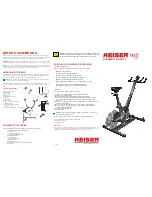
9
HEART RATE
As you exercise, your heart beat increases. This is often used as a measure of the required intensity of
an exercise. You need to exercise hard enough to condition your circulatory system, and increase your
pulse rate, but not enough to strain your heart.
Your initial level of fitness is important when developing an exercise program for you. When starting,
you can get a good training effect with a heart rate of 110-120 beats per minute (BPM). If you are
more fit, you will need a higher threshold of stimulation.
To begin with, you should exercise at a level that elevates your heart rate to about 65 to 70% of your
maximum. If you find this is too easy, you may want to increase it, but it is better to lean on the
conservative side.
As a rule of thumb, the maximum heart rate is 220 minus your age. As you increase in age, your
heart, like other muscles, loses some of its efficiency. Some of its natural loss is won back as fitness
improves. The following table is a guide to those who are “starting fitness.”
Age
Target
Heart
Rate
25
30 35 40 45 50 55 60 65
10
Second
Count
23
22 22 21 20 19 19 18 18
Beats per Minute 138 132 132 126 120 114 114 108 108
PULSE COUNT
The pulse count (on your wrist or carotid artery in the neck, taken with two index fingers) is done
for ten seconds, taken a few seconds after you stop exercising. This is for two reasons: (a) 10 seconds
is long enough for accuracy, (b) the pulse count is to approximate your BPM rate at the time you are
exercising. Since heart rate slows as you recover, a longer count isn’t as accurate.
The target is not a magic number, but a general guide. If you’re above average with your fitness, you
may work comfortably a little above that suggested for your age group. The following table is a guide.
Age
Target
Heart
Rate
25
30 35 40 45 50 55 60 65
10
Second
Count
26 26 25 24 23 22 22 21 20
Beats
per
Minute
156 156 150 144 138 132 132 126 120
Don’t push yourself too hard to reach the figures on this table. It can be very uncomfortable if you
over exercise. Let it happen naturally as you work through your program. Remember, the target is a
guide, not a rule, a little above or below is just fine.
Two final comments: (1) don’t be concerned with day to day variations in your pulse rate, being
under pressure or not enough sleep can affect it; (2) your pulse rate is a guide, don’t become a slave
to it.
Summary of Contents for SB2.0
Page 18: ...18 CONSOLE OVERVIEW...
Page 20: ...20 EXPLODED VIEW DRAWING...








































